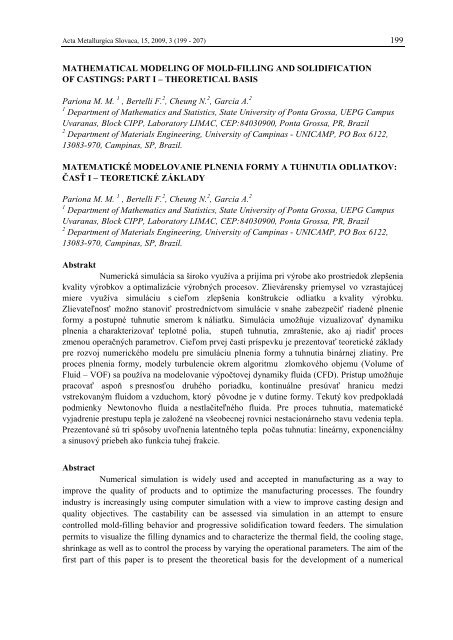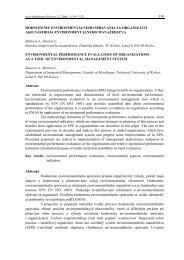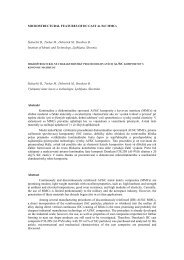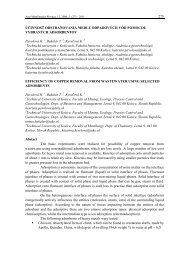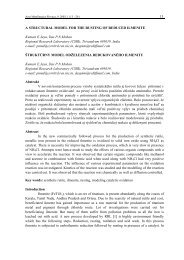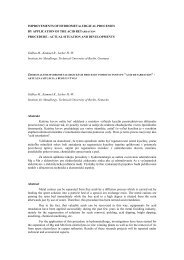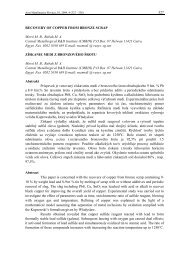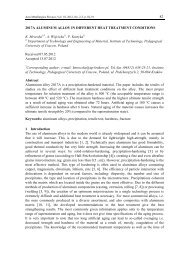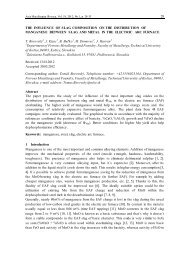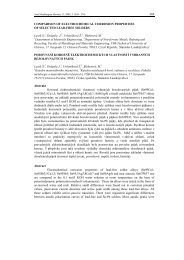199 mathematical modeling of mold-filling and solidification - Acta ...
199 mathematical modeling of mold-filling and solidification - Acta ...
199 mathematical modeling of mold-filling and solidification - Acta ...
Create successful ePaper yourself
Turn your PDF publications into a flip-book with our unique Google optimized e-Paper software.
<strong>Acta</strong> Metallurgica Slovaca, 15, 2009, 3 (<strong>199</strong> - 207) <strong>199</strong><br />
MATHEMATICAL MODELING OF MOLD-FILLING AND SOLIDIFICATION<br />
OF CASTINGS: PART I – THEORETICAL BASIS<br />
Pariona M. M. 1 , Bertelli F. 2 , Cheung N. 2 , Garcia A. 2<br />
1 Department <strong>of</strong> Mathematics <strong>and</strong> Statistics, State University <strong>of</strong> Ponta Grossa, UEPG Campus<br />
Uvaranas, Block CIPP, Laboratory LIMAC, CEP:84030900, Ponta Grossa, PR, Brazil<br />
2 Department <strong>of</strong> Materials Engineering, University <strong>of</strong> Campinas - UNICAMP, PO Box 6122,<br />
13083-970, Campinas, SP, Brazil.<br />
MATEMATICKÉ MODELOVANIE PLNENIA FORMY A TUHNUTIA ODLIATKOV:<br />
ČASŤ I – TEORETICKÉ ZÁKLADY<br />
Pariona M. M. 1 , Bertelli F. 2 , Cheung N. 2 , Garcia A. 2<br />
1 Department <strong>of</strong> Mathematics <strong>and</strong> Statistics, State University <strong>of</strong> Ponta Grossa, UEPG Campus<br />
Uvaranas, Block CIPP, Laboratory LIMAC, CEP:84030900, Ponta Grossa, PR, Brazil<br />
2 Department <strong>of</strong> Materials Engineering, University <strong>of</strong> Campinas - UNICAMP, PO Box 6122,<br />
13083-970, Campinas, SP, Brazil.<br />
Abstrakt<br />
Numerická simulácia sa široko využíva a prijíma pri výrobe ako prostriedok zlepšenia<br />
kvality výrobkov a optimalizácie výrobných procesov. Zlievárensky priemysel vo vzrastajúcej<br />
miere využíva simuláciu s cieľom zlepšenia konštrukcie odliatku a kvality výrobku.<br />
Zlievateľnosť možno stanoviť prostredníctvom simulácie v snahe zabezpečiť riadené plnenie<br />
formy a postupné tuhnutie smerom k náliatku. Simulácia umožňuje vizualizovať dynamiku<br />
plnenia a charakterizovať teplotné polia, stupeň tuhnutia, zmraštenie, ako aj riadiť proces<br />
zmenou operačných parametrov. Cieľom prvej časti príspevku je prezentovať teoretické základy<br />
pre rozvoj numerického modelu pre simuláciu plnenia formy a tuhnutia binárnej zliatiny. Pre<br />
proces plnenia formy, modely turbulencie okrem algoritmu zlomkového objemu (Volume <strong>of</strong><br />
Fluid – VOF) sa používa na modelovanie výpočtovej dynamiky fluida (CFD). Prístup umožňuje<br />
pracovať aspoň s presnosťou druhého poriadku, kontinuálne presúvať hranicu medzi<br />
vstrekovaným fluidom a vzduchom, ktorý pôvodne je v dutine formy. Tekutý kov predpokladá<br />
podmienky Newtonovho fluida a nestlačiteľného fluida. Pre proces tuhnutia, matematické<br />
vyjadrenie prestupu tepla je založené na všeobecnej rovnici nestacionárneho stavu vedenia tepla.<br />
Prezentované sú tri spôsoby uvoľnenia latentného tepla počas tuhnutia: lineárny, exponenciálny<br />
a sinusový priebeh ako funkcia tuhej frakcie.<br />
Abstract<br />
Numerical simulation is widely used <strong>and</strong> accepted in manufacturing as a way to<br />
improve the quality <strong>of</strong> products <strong>and</strong> to optimize the manufacturing processes. The foundry<br />
industry is increasingly using computer simulation with a view to improve casting design <strong>and</strong><br />
quality objectives. The castability can be assessed via simulation in an attempt to ensure<br />
controlled <strong>mold</strong>-<strong>filling</strong> behavior <strong>and</strong> progressive <strong>solidification</strong> toward feeders. The simulation<br />
permits to visualize the <strong>filling</strong> dynamics <strong>and</strong> to characterize the thermal field, the cooling stage,<br />
shrinkage as well as to control the process by varying the operational parameters. The aim <strong>of</strong> the<br />
first part <strong>of</strong> this paper is to present the theoretical basis for the development <strong>of</strong> a numerical
<strong>Acta</strong> Metallurgica Slovaca, 15, 2009, 3 (<strong>199</strong> - 207) 200<br />
model for simulation <strong>of</strong> <strong>mold</strong>-<strong>filling</strong> <strong>and</strong> <strong>solidification</strong> <strong>of</strong> a binary alloy. For the <strong>mold</strong> <strong>filling</strong><br />
process, turbulence models in addition to the Fractional Volume (Volume <strong>of</strong> Fluid - VOF)<br />
algorithm is used to model the computational fluid dynamics (CFD). The approach allows one to<br />
h<strong>and</strong>le, with at least second order accuracy, the continuously moving boundary between the<br />
injected fluid <strong>and</strong> the air that initially is in the <strong>mold</strong> cavity. The liquid metal assumes Newtonian<br />
fluid <strong>and</strong> incompressible fluid conditions. For the <strong>solidification</strong> process, the <strong>mathematical</strong><br />
formulation <strong>of</strong> heat transfer is based on the general equation <strong>of</strong> unsteady state heat conduction.<br />
Three forms <strong>of</strong> latent heat release during <strong>solidification</strong> are presented: linear, exponential <strong>and</strong><br />
sinusoid behavior as a function <strong>of</strong> the solid fraction.<br />
Keywords: numerical simulation, finite-element method, <strong>mold</strong>-<strong>filling</strong>, <strong>solidification</strong>, heat<br />
generation<br />
1. Introduction<br />
In the last years a perceptible evolution <strong>of</strong> numerical <strong>modeling</strong> in all science areas can<br />
be easily detected [1]. Particularly for casting processes, a great progress happened due to the<br />
evolution <strong>of</strong> both hardware <strong>and</strong> s<strong>of</strong>tware used for simulation purposes. The stages <strong>of</strong> casting can<br />
be defined as: heating-melting, <strong>mold</strong>-<strong>filling</strong> <strong>and</strong> <strong>solidification</strong>. Each stage has a great influence<br />
on the final casting quality. Mold-<strong>filling</strong> can be classified as a problem <strong>of</strong> fluid mechanics with<br />
many phenomena involved such as, molten metal turbulence; heat transfer along the metal/<strong>mold</strong><br />
system; pressure variation inside the casting, etc. [2]. The <strong>modeling</strong> <strong>of</strong> <strong>solidification</strong> associated<br />
to the fluid dynamics permits many phenomena <strong>and</strong> parameters which are important to assure a<br />
free defect product to be analyzed, e.g. [3]: heat transfer in the whole system (casting <strong>and</strong> <strong>mold</strong>),<br />
thermal gradients, macrosegregation <strong>and</strong> microsegregation [4], thermal stresses in metal <strong>and</strong><br />
<strong>mold</strong>, porosity formation, etc. Despite its importance, the simulation <strong>of</strong> the casting process<br />
becomes a challenge due to the complexity <strong>of</strong> the simultaneous fluid-thermal-mechanics<br />
phenomena which are involved. Besides, they are transient phenomena <strong>and</strong> experimental<br />
measurements permitting fluid motion to be characterized are not an easy task [2]. In this paper<br />
a numerical model is developed permitting the simulation <strong>of</strong> both <strong>mold</strong> <strong>filling</strong> <strong>and</strong> <strong>solidification</strong><br />
<strong>of</strong> binary alloys castings. The moving boundary liquid metal/air is modeled using the VOF<br />
method to trace the free surface during <strong>mold</strong> <strong>filling</strong>.<br />
2. Governing equations<br />
The <strong>mathematical</strong> <strong>modeling</strong> <strong>of</strong> <strong>mold</strong>-<strong>filling</strong> <strong>and</strong> <strong>solidification</strong> <strong>of</strong> metallic alloys will<br />
be described in the present study by the following equations:<br />
2.1 Mold <strong>filling</strong><br />
In the simulation <strong>of</strong> <strong>mold</strong> <strong>filling</strong>, the fluid was considered to be incompressible <strong>and</strong><br />
having Newtonian characteristics. The mass, momentum <strong>and</strong> energy conservation equations that<br />
govern fluid flow <strong>and</strong> heat transfer can be expressed in vector calculus notation, as it follows:<br />
a) Mass conservation equation (continuity) for incompressible fluids:<br />
∂ u ∂ v ∂ w<br />
+ + = 0<br />
∂ x ∂ y ∂ z<br />
(1)
<strong>Acta</strong> Metallurgica Slovaca, 15, 2009, 3 (<strong>199</strong> - 207) 201<br />
where v r =(u, v, w) is the velocity.<br />
b) The momentum conservation equation (Navier–Stokes) can be expressed as [5]:<br />
r<br />
⎧∂<br />
v r r⎫<br />
2 r r<br />
ρ ⎨ + v ∇. v⎬<br />
= -∇ P + µ ∇ v + ρg<br />
⎩ ∂ t ⎭<br />
(2)<br />
where, ρ is the density assumed to be constant, P r is the pressure, µ is the dynamic viscosity<br />
constant <strong>and</strong> g r is the gravity vector.<br />
c) The energy conservation equation for the liquid region is given by [6]:<br />
⎛ ∂T<br />
r ⎞ 2 L ∂φ<br />
ρc⎜<br />
+ v.<br />
∇T<br />
⎟ = k∇<br />
T −<br />
⎝ ∂t<br />
⎠ c ∂t<br />
(3)<br />
where c is the specific heat, k is the thermal conductivity, L is the latent heat, φ is the<br />
volumetric liquid fraction <strong>and</strong> T is the temperature.<br />
When the molten metal starts to fill the <strong>mold</strong>, the turbulence phenomenon begins.<br />
Turbulence means that the instantaneous velocity is fluctuating at every point in the flow field.<br />
Many <strong>mathematical</strong> models existing in the literature are used to simulate the turbulence,, i.e., a<br />
total <strong>of</strong> eight turbulence models are available [5; 7, 8; 9; 10; 11; 12]. These models acronyms<br />
<strong>and</strong> names are: St<strong>and</strong>ard k-ε Model, Zero Equation Model, RNG - (Re-normalized Group<br />
Model), NKE - (New κ-ε Model), GIR, SZL, St<strong>and</strong>ard k-ω Model, SST. The κ-ε model <strong>and</strong> its<br />
extensions entail solving partial differential equations for the turbulent kinetics energy κ <strong>and</strong> its<br />
dissipation rate ε.<br />
d) The turbulent kinetics energy equation for NKE - (New κ-ε Model) is given by:<br />
∂(<br />
ρκ ) ∂(<br />
ρuκ)<br />
∂(<br />
ρvκ<br />
) ∂(<br />
ρwκ)<br />
∂ ⎛ µ<br />
+ + + = ⎜ t<br />
∂t<br />
∂x<br />
∂y<br />
∂z<br />
∂x<br />
⎝ σ k<br />
C βµ ⎛ ∂T<br />
∂T<br />
∂T<br />
⎞<br />
− ρε +<br />
4 t<br />
⎜ g x + g y + g z<br />
⎟<br />
σ t ⎝ ∂x<br />
∂y<br />
∂z<br />
⎠<br />
∂κ<br />
⎞ ∂ ⎛ µ<br />
⎟ + ⎜ t<br />
∂x<br />
∂<br />
⎠ y ⎝ σ k<br />
∂κ<br />
⎞ ∂ ⎛ µ<br />
⎟ + ⎜ t<br />
∂y<br />
∂<br />
⎠ z ⎝ σ k<br />
∂κ<br />
⎞<br />
⎟<br />
+ µ tΦ<br />
∂z<br />
⎠<br />
(4)<br />
The viscous dissipation term in tensor notation is:<br />
⎛<br />
⎜ ∂u<br />
Φ = µ i<br />
⎜<br />
⎝<br />
∂xk<br />
∂u<br />
⎞<br />
k ∂u<br />
+ ⎟ i<br />
∂x<br />
j ⎟<br />
⎠<br />
∂xk<br />
where σ t , is the turbulent Pr<strong>and</strong>tl (Schmidt) number; g x , g y <strong>and</strong> g z , are the components <strong>of</strong><br />
acceleration due to gravity <strong>and</strong> u i , the magnitude <strong>of</strong> the velocity vector.<br />
The turbulent viscosity is calculated as a function <strong>of</strong> the turbulent kinetics energy<br />
parameter, κ, <strong>and</strong> its dissipation rate ε, that is:<br />
2<br />
κ<br />
µ t = ρCµ<br />
ε<br />
where, C µ , is the turbulent constant; κ is the turbulent kinetics energy parameter <strong>and</strong> ε is the<br />
turbulent kinetics energy dissipation rate.
<strong>Acta</strong> Metallurgica Slovaca, 15, 2009, 3 (<strong>199</strong> - 207) 202<br />
For the incompressible solution algorithm the following equation is used:<br />
dρ 1<br />
=<br />
dP β<br />
where β is the bulk modulus.<br />
e) The dissipation rate equation for NKE - (New k-ε Model) is given by:<br />
∂( ρε ) ∂( ρuε<br />
) ∂( ρvε<br />
) ∂( ρwε<br />
) ∂ ⎛ µ ⎞ ⎛ ⎞ ⎛ ⎞<br />
+ + + = ⎜ t ∂ε<br />
∂ µ<br />
⎟ +<br />
+ ⎜ ⎟<br />
⎜ t ∂ε<br />
∂ µ<br />
⎟ t ∂ε<br />
+<br />
∂t<br />
∂x<br />
∂y<br />
∂z<br />
∂x<br />
⎝ σ ε ∂x<br />
⎠ ∂y<br />
⎝ σε ∂y<br />
⎠ ∂z<br />
⎝ σ ε ∂z<br />
⎠<br />
2<br />
ε ε Cµ<br />
(1 C3)<br />
β1ρκ<br />
⎛ ∂T<br />
∂T<br />
∂T<br />
⎞<br />
C1ε<br />
µ t Φ C2ρ<br />
+<br />
⎜ g x + g y + g z<br />
⎟<br />
κ κ σ t ⎝ ∂x<br />
∂y<br />
∂z<br />
⎠<br />
(5)<br />
The new functions; deformation tensor S ij , <strong>and</strong> the antisymetric tensor W ij , are based<br />
on the velocity components u k in the flow field.<br />
1<br />
Sij<br />
= ( ui,<br />
j + u j,<br />
i )<br />
2<br />
Wij<br />
= 1<br />
( ui,<br />
j − u j,<br />
i ) + Cµ Ω mε<br />
mij<br />
2<br />
where, C µ , is the turbulent constant; Ω m is the angular velocity <strong>of</strong> the coordinate system <strong>and</strong> ε mij<br />
is the alternating tensor operator.<br />
The invariants are:<br />
η = κ<br />
2S ij S ij <strong>and</strong> κ<br />
ξ =<br />
ε<br />
2W ij<br />
ε<br />
Wij<br />
C 1<br />
µ =<br />
, ⎛ η<br />
2 2<br />
4 + 1.5 η + ξ<br />
⎟ ⎞<br />
C 1ε<br />
= max ⎜C1M<br />
⎝ η + 5 ⎠<br />
where, C 1ε , C 2 , σ k , σ ε , σ t , C 3 , C 4 , C 1M <strong>and</strong> β 1 are constants.<br />
2.2 Free surface <strong>modeling</strong><br />
In the last years due to s<strong>of</strong>tware <strong>and</strong> hardware technological evolutions, intensive<br />
studies <strong>and</strong> applications concerning the <strong>mold</strong> <strong>filling</strong> by metallic fluids can be found in the<br />
literature. During the <strong>mold</strong> <strong>filling</strong> process, liquid metal <strong>and</strong> air coexist in the <strong>mold</strong> <strong>and</strong> the<br />
interface position changes rapidly with time [13]. It is essential to introduce a free-surfacetracking<br />
algorithm to analyze the <strong>filling</strong> process. The Volume <strong>of</strong> Fluid Method (VOF) is the<br />
most widely used method for free-surface tracking during <strong>mold</strong> <strong>filling</strong> [13]. In a three<br />
dimensional rectangular coordinate frame, the transport equation on the VOF, F(r,t), for an<br />
incompressible fluid can be written as:<br />
∂ F r<br />
+ ∇ F.<br />
v = 0<br />
∂ t<br />
(6)<br />
The F(r,t) function governed by the above equation is unity in the region occupied by<br />
the fluid <strong>and</strong> zero in the empty region. For the given computational domain, the F(r,t) field
<strong>Acta</strong> Metallurgica Slovaca, 15, 2009, 3 (<strong>199</strong> - 207) 203<br />
obtained from Eq. (6) gives the information for the free surface. The cells with F(r,t) values<br />
between 0 <strong>and</strong> 1 are the free surface cells. The VOF method has been applied successfully to<br />
many engineering problems involving free surfaces including the <strong>mold</strong> <strong>filling</strong> problem.<br />
However, since the original VOF method uses an explicit differencing method in time, large<br />
computational time is required to analyze a typical <strong>filling</strong> problem.<br />
Im et al. [13] state that the use a time-implicit VOF method to alleviate the severe<br />
time step restriction is more efficient than the time-explicit VOF method. The time implicit VOF<br />
method is based on the assumption that a cell being filled cannot transmit fluid to its neighboring<br />
cells until it is completely filled. Once the cell is filled, it can transmit fluid to neighboring cells.<br />
However, According to McBride et al. [14] almost all viable simulation tools for the simulation<br />
<strong>of</strong> free-surface flow in shaped castings use a fixed grid approach as defined by the <strong>mold</strong><br />
geometry, <strong>and</strong> they typically employ the concept <strong>of</strong> volume <strong>of</strong> fluid (VOF) to track the interface,<br />
as originally proposed by Hirt <strong>and</strong> Nichols [15].<br />
The numerical method used to analyze fluid flow <strong>and</strong> thermal behavior during <strong>and</strong><br />
after <strong>filling</strong> in the <strong>mold</strong> is described as follows [13]. Continuity, momentum, energy <strong>and</strong> F(r,t)-<br />
transport equations are discretized using the fully implicit method in time. Firstly, the velocity<br />
<strong>and</strong> pressure fields are obtained from the momentum <strong>and</strong> continuity equations. Then the new<br />
fluid configuration is computed from Eq. (6). The energy equation is solved for the fluidoccupied<br />
region to determine the temperature <strong>and</strong> the liquid fraction. The updated values <strong>of</strong><br />
F(r,t) are utilized to modify the velocity <strong>and</strong> pressure, <strong>and</strong> then the temperatures <strong>and</strong> liquid<br />
fractions are updated based on the modified velocity <strong>and</strong> pressure. This iteration procedure is<br />
repeated until the total fluid volume <strong>and</strong> temperature changes are small enough to satisfy the<br />
prescribed convergence criteria. If the convergence criteria are satisfied, the time is advanced.<br />
This time-implicit VOF method is adopted to reduce the tremendous computation time that is<br />
required when the original VOF method is used [13].<br />
According to Kermanpur et al. [16], <strong>mold</strong> <strong>filling</strong> problems involve tracking free<br />
surfaces that are the boundaries between liquid metal <strong>and</strong> the surrounding air. The most<br />
commonly used method to describe free surfaces is the VOF. It enables the tracking <strong>of</strong> transientfree<br />
surfaces with arbitrary topology <strong>and</strong> deformations (e.g., fluid surface break-up <strong>and</strong><br />
coalescence). The ‘true’ VOF method consists <strong>of</strong> three main components:<br />
1. A fluid fraction function F(r,t) which is equal to 1.0 in fluid regions, <strong>and</strong> equal to 0.0 in<br />
voids. Since the fluid configuration may change with time, F(r,t) is a function <strong>of</strong> time,<br />
t, as well as space, r. Averaged over a computational control volume, the fluid fraction<br />
function has a fractional value in cells containing a free surface.<br />
2. Zero shear stress <strong>and</strong> constant pressure boundary conditions are applied at free<br />
surfaces.<br />
3. A special advection algorithm is used for tracking sharp free surfaces.<br />
The boundary conditions at the free surface are; normal <strong>and</strong> tangential stresses equal<br />
to zero.<br />
A free surface advection method must preserve the sharpness <strong>of</strong> the interface having<br />
minimal free surface distortion. Generally, such advection algorithms are based on geometric<br />
reconstruction <strong>of</strong> the free surface using the values <strong>of</strong> F(r,t) at the grid nodes [16]. Sometimes, a<br />
free surface is approximated by a density discontinuity between metal <strong>and</strong> air <strong>and</strong> flow equations<br />
are solved for both fluids. In that case it is difficult to enforce correct boundary conditions at the<br />
surface. This is because free surface pressure <strong>and</strong> velocities in the two-fluid approach are not set
<strong>Acta</strong> Metallurgica Slovaca, 15, 2009, 3 (<strong>199</strong> - 207) 204<br />
explicitly, but are computed by solving the flow equations <strong>and</strong> these flow equations are solved in<br />
terms <strong>of</strong> mixture variables. Since densities <strong>of</strong> liquid metal <strong>and</strong> air differ greatly (e.g., by a factor<br />
<strong>of</strong> 7000 for steel), the mixture velocity may not always be an accurate measure <strong>of</strong> the relative<br />
motion <strong>of</strong> metal <strong>and</strong> air [16].<br />
Kim et al. [17] proposed an interesting flow chart <strong>of</strong> the <strong>mold</strong> <strong>filling</strong> computational<br />
procedure, as shown in Fig. 1. In the first stage <strong>of</strong> the numerical analysis, an initial grid is<br />
generated <strong>and</strong> values for the order <strong>of</strong> surface refinement, material properties, boundary<br />
conditions, <strong>and</strong> initial volume fractions are the model input. Then, the time step is increased <strong>and</strong><br />
the <strong>filling</strong> pattern is selected for each element, <strong>and</strong> the free surface is predicted by the <strong>filling</strong><br />
pattern. In the next stage, through the refinement <strong>and</strong> mergence procedure, an adaptive grid is<br />
generated. According to the volumetric fraction at a given time during <strong>filling</strong>, the domain<br />
element for the FEM (Finite Element Method) analysis is created. Then, by the FEM analysis,<br />
the velocity <strong>and</strong> pressure fields are obtained <strong>and</strong> the flow rate in each element is calculated.<br />
Subsequently, the procedure <strong>of</strong> advection treatment is accomplished <strong>and</strong> the volume fraction in<br />
each element is obtained. These procedures are iterated until the current <strong>filling</strong> time reaches the<br />
total time.<br />
Fig.1 Flow chart <strong>of</strong> the computational procedure [17]<br />
One <strong>of</strong> the requirements that should be satisfied in the VOF method for <strong>mold</strong> <strong>filling</strong>,<br />
is the conservation <strong>of</strong> the F(r,t) function even though with the presence <strong>of</strong> convection. This<br />
method uses a minimum <strong>of</strong> stored information <strong>and</strong> it follows regions rather than boundaries,<br />
which avoids the logic problems associated with intersecting surfaces. The derivatives <strong>of</strong> this<br />
function can be used to estimate the orientation <strong>of</strong> the fluid surface, improving the<br />
computational efficiency [18].
<strong>Acta</strong> Metallurgica Slovaca, 15, 2009, 3 (<strong>199</strong> - 207) 205<br />
2.3 Equations for <strong>solidification</strong><br />
The <strong>mathematical</strong> formulation <strong>of</strong> heat transfer to predict the temperature distribution<br />
during <strong>solidification</strong> is based on the general equation <strong>of</strong> unsteady state heat conduction, which is<br />
given by [1; 15; 19; 20; 21; 22]:<br />
∂ ( ρ . c.<br />
T ) = ∇.(<br />
k∇T<br />
) + Q&<br />
(7)<br />
∂ t<br />
where ρ is the density [kgm -3 ]; c is the specific heat [J kg -1 K -1 ]; k is the thermal conductivity<br />
[Wm -1 K -1 ]; ∂T/∂t is the cooling rate [K s -1 ], T is the temperature [K], t is time [s], x, y <strong>and</strong> z are<br />
the space coordinates [m] <strong>and</strong> Q & represents the term associated to the internal heat generation<br />
due to the phase change. For this equation, it was assumed that the thermal conductivity, density<br />
<strong>and</strong> specific heat vary with temperature [22].<br />
The boundary condition at the <strong>mold</strong> external surface is given by:<br />
∂T<br />
− -k = h ( T - T∞<br />
)<br />
(8)<br />
∂n<br />
Where h is the ambient surface convection heat transfer coefficient associated with<br />
free convection, n is the unit vector outward normal to the s<strong>and</strong> <strong>mold</strong>, T ∞ is the environment air<br />
temperature <strong>and</strong> T is the temperature at the outer <strong>mold</strong> wall.<br />
2.3.1. Phase change<br />
When there is a phase change from liquid to solid, a heat source term arises, which is<br />
given by an explicit solid fraction–temperature relationship. The solid fraction depends on a<br />
number <strong>of</strong> parameters; however, it is quite reasonable to assume f s varying only with<br />
temperature, where f s is the solid fraction <strong>and</strong> L is the latent heat <strong>of</strong> fusion [J kg -1 ]. So, we can<br />
write:<br />
c ’ = c–L.∂f s /∂T (9)<br />
The term c’ can be considered a pseudo-specific heat. The sub-indices S <strong>and</strong> L<br />
indicate solid <strong>and</strong> liquid, respectively [22].<br />
In the current system, no external heat source is applied <strong>and</strong> the only heat generation<br />
is due to the latent heat <strong>of</strong> <strong>solidification</strong>, L (Jkg -1 ) or ∆H (Jm -3 ). Q & is proportional to the rate <strong>of</strong><br />
change <strong>of</strong> the solid fraction, f s , as it follows [21; 22; 23]:<br />
f f<br />
Q & ∂<br />
H<br />
s ∂<br />
= ∆ = ρL<br />
s<br />
(10)<br />
∂t<br />
∂t<br />
In many systems, especially when the undercooling is small, the solid fraction may be<br />
assumed as being dependent on temperature only. Different forms have been proposed to take<br />
into account the evolution <strong>of</strong> solid fraction with temperature. The simplest approach is that given<br />
by a linear relationship [23]:<br />
f s<br />
⎧0<br />
⎪<br />
= ⎨(<br />
Tl<br />
⎪<br />
⎩<br />
− T ) /( Tl<br />
− Ts<br />
)<br />
1<br />
T > Tl<br />
Ts<br />
≤ T ≤ Tl<br />
T < Ts<br />
(11)
<strong>Acta</strong> Metallurgica Slovaca, 15, 2009, 3 (<strong>199</strong> - 207) 206<br />
where T l <strong>and</strong> T s are the liquidus <strong>and</strong> the solidus temperatures (K), respectively. Another widely<br />
used expression is the Scheil equation, which assumes uniform solute concentration in the liquid<br />
but no diffusion in the solid [23]:<br />
−1/1−k ⎛ T<br />
o<br />
m − T ⎞<br />
f s = 1 − ⎜ ⎟<br />
Tm<br />
T<br />
⎝ − l ⎠<br />
(12)<br />
where T m is the melting point <strong>of</strong> the solvent metal (K),<strong>and</strong> k o is the equilibrium partition<br />
coefficient <strong>of</strong> the alloy.<br />
Eq. (10) defines the heat flux [3] which is released during liquid cooling <strong>and</strong><br />
<strong>solidification</strong>. In classical models, the heat generated after <strong>solidification</strong> is assumed to be zero,<br />
i.e., for T< T s , Q & = 0. However, experimental investigations showed that lattice defects <strong>and</strong><br />
vacancies are condensed in the already solidified part <strong>of</strong> the crystal <strong>and</strong> the enthalpy <strong>of</strong> the solid<br />
increases <strong>and</strong> thus the latent heat will decrease. Based on this fact, another way to represent the<br />
change <strong>of</strong> the solid fraction during <strong>solidification</strong> can be written as [3]:<br />
2<br />
⎡ π ( T − T ) ⎤<br />
( T − T ) + ( Ts<br />
− T )(1 − cos<br />
l<br />
l<br />
l ⎢ ⎥<br />
π<br />
⎣ 2( Ts<br />
− Tl<br />
)<br />
f =<br />
⎦<br />
s<br />
( Tl<br />
− Ts<br />
)(( 1−<br />
2 / π )<br />
(13)<br />
Combining Eqs. (7), (9) <strong>and</strong> (10), the new unsteady state heat conduction equation<br />
can be expressed in the form [4; 23]:<br />
∂ ( ρ c´<br />
T )<br />
= ∇.( k∇<br />
T)<br />
∂ t<br />
(14)<br />
At the range <strong>of</strong> temperatures where <strong>solidification</strong> occurs for binary metallic alloys, the<br />
physical properties will be evaluated taking into account the amount <strong>of</strong> liquid <strong>and</strong> solid that<br />
coexists in equilibrium at each temperature, as shown by Eqs. (9), (10) <strong>and</strong> (14).<br />
3. Conclusions<br />
A comprehensive theoretical basis regarding equations <strong>of</strong> fluid mechanics <strong>and</strong> heat<br />
flow has been shown. Like other CFD problems, the momentum equation, the continuity<br />
equation, <strong>and</strong> the energy equation are the partial differential equations that are essential in the<br />
numerical analysis <strong>of</strong> the casting process. The moving boundary liquid metal/air is modeled<br />
using the VOF method to trace the free surface in <strong>mold</strong> <strong>filling</strong> processes. The latent heat release<br />
during the unsteady <strong>solidification</strong> phenomenon is taken into account as a source term in the<br />
energy equation. The implementation <strong>of</strong> such equations is aimed to furnish important<br />
information such as <strong>filling</strong> dynamics <strong>and</strong> the thermal field along the casting process.<br />
Acknowledgements<br />
The authors acknowledge financial support provided by CNPq (The Brazilian<br />
Research Council), FAPESP (The Scientific Research Foundation <strong>of</strong> the State <strong>of</strong> São Paulo,<br />
Brazil) <strong>and</strong> CAPES - Coordenação de Aperfeiçoamento de Pessoal de Nível Superior.
<strong>Acta</strong> Metallurgica Slovaca, 15, 2009, 3 (<strong>199</strong> - 207) 207<br />
Literature<br />
[1] Guo Z., Saunders N., Miodownik A.P., Schill J.-Ph.: Materials Science <strong>and</strong> Engineering,<br />
vol. A 413–414, 2005, pp.465–469.<br />
[2] Shepel S.V., Paolucci S.: Applied Thermal Engineering, vol.22, 2002, pp-229-2418.<br />
[3] Radovic Z., Lalovic M.: Journal <strong>of</strong> Materials Processing Technology, vol.160, 2005,<br />
pp.156–159.<br />
[4] Katzarov I.H.: International Journal <strong>of</strong> Heat <strong>and</strong> Mass Transfer, vol.46, 2003, pp.1545-<br />
1552.<br />
[5] Zaidi K., Abbes B., Teodosiu C.: Computer Methods in Applied Mechanics <strong>and</strong><br />
Engineering, vol.144, <strong>199</strong>7, pp.227-233.<br />
[6] Son G., Dhi V.K.: International Journal <strong>of</strong> Heat <strong>and</strong> Mass Transfer, vol.51, 2008, pp.1156–<br />
1167.<br />
[7] H<strong>and</strong>book Ansys. 2008 Inc. Canonsburg, PA.<br />
[8] Aboutalebi M.R., Guthrie R.I.L., Seyedein S.H.: Applied Mathematical Modelling, vol.31,<br />
2007, pp.1671–1689.<br />
[9] Sharma A.K., Velusamy K. Balaji C.: Annals <strong>of</strong> Nuclear Energy. vol.35, 2008, pp.1502-<br />
1514.<br />
[10] Cheng T.S., Yang W.J.: Computers & Fluids, vol.37, 2008, pp.194–206.<br />
[11] Ha M.Y., Lee H.G., Seong S.H.: Journal <strong>of</strong> Materials Processing Technology, vol.133,<br />
2003, pp.322-339.<br />
[12] Pericleous K., Bojarevics V., Djambazov G., Harding R.A., Wickins M.: Applied<br />
Mathematical Modelling, vol.30, 2006, pp.1262–1280.<br />
[13] Im I.-T., Kim W.-S., Lee K.-S.: International Journal <strong>of</strong> Heat <strong>and</strong> Mass Transfer, vol.44,<br />
2001, pp.1507-1515.<br />
[14] McBride D., Cr<strong>of</strong>t T.N., Cross M.: Computers & Fluids, vol. 37, 2008, pp.170–180.<br />
[15] Hirt C.W., Nichols B.D.: Journal <strong>of</strong> Computational Physics, vol. 39, 1981, pp. 201-225.<br />
[16] Kermanpur A., Mahmoudi S., Hajipour A.: Journal <strong>of</strong> Materials Processing Technology.<br />
vol.206, 2008, pp.62-68.<br />
[17] Kim K.D., Yang D.Y., Jeong J.H.: Computer Methods in Applied Mechanics <strong>and</strong><br />
Engineering, vol.195, 2006, pp.6799–6821.<br />
[18] Babaei R., Abdollahi J., Homayonifar P., Varahram N., Davami P.: Computer Methods in<br />
Applied Mechanics <strong>and</strong> Engineering, vol.195, 2006, pp.775–795.<br />
[19] Miao Y.-C., Zhang X.-M., Di H.-S., Wang G.D.: Journal <strong>of</strong> Materials Processing<br />
Technology, vol.174, 2006, pp.7–13.<br />
[20] Janik M., Dyja H.: Journal <strong>of</strong> Materials Processing Technology, vol.157–158, 2004,<br />
pp.177-182.<br />
[21] Ferreira I.L., Spinelli J.E., Pires J.C., Garcia A.: Materials Science <strong>and</strong> Engineering, vol. A<br />
408, 2005, pp.317–325.<br />
[22] Santos C.A., Fortaleza E.L., Ferreira C.R.F., Spim J.A., Garcia A.: Modelling <strong>and</strong><br />
Simulation in Materials Science <strong>and</strong> Engineering, vol.13, 2005, p.1071–1087.<br />
[23] Shi Z., Guo Z.X.: Materials Science <strong>and</strong> Engineering, vol.A365, 2004, pp. 311–317.


